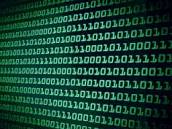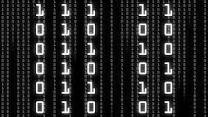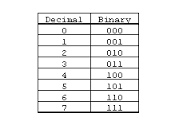Binary Numbers in History



Binary Code in History - the Foundation of Modern Computer Technology
The binary numeral system underlies the modern technology of electronic digital computers. Computer memory consists of small elements that can only be in two states, off and on, which are associated with the two numbers of 1 and 0. These elements are referred to as bits, and all the information we send and receive via computers is in the form of bits. It’s a numbering system that is usually given credit to the German polymath and philosopher Gottfried Wilhelm von Leibniz in the late 1600’s, but the truth is, it was around much earlier.
Gottfried Wilhelm von Leibniz was a philosopher and mathematician in search of a better model. In the late 1600’s, he decided there was a need for a new and purer arithmetic than our common decimal system; he saw a correlation for this model of new arithmetic in the five-millennia-old book that is at the heart of Chinese philosophy: The I-Ching, or Book of Changes in English. Among scholars there is some debate as to exactly what Leibniz thought he had found in the Chinese Literature he had received through a correspondence, but there is no doubt that our binary numbering system was there, existing in the oldest of the Chinese Classics.
Originally the I-Ching was a divination manual used in the Western Zhou period (1000-750 BC), but the point I’m referring to here is the manner in which binary poles are represented in the text. The binary poles are represented as the yin and the yang, like 1 and 0; as abstract concepts they can represent the poles of any binary set, but in the I-Ching they are discussed as being male and female as they are combined in sets of three to form eight basic trigrams, which in turn combine to give 64 hexagrams, a process and a system that is at the heart of the I-Ching’s system of divination. The I-Ching was probably the most ambitious use of binary code to date as it was used to represent human life itself; and even the reading of the I-Ching is done in a binary format with the flipping of a coin, thereby producing an output of two results, or with yarrow sticks to produce a hexagram which is then accompanied by an explanatory text in order to receive the I-Ching’s analysis. As with any system used to decipher some kind of divine message, like the use of tea leaves for example, the reading or the outcome of one’s interpretation will be largely dependent on one’s understanding of the divine (almost as if the reader creates their own response). So, attempting to predict the future in such a way might be disappointing for a reader, but used as a tool to tap into one’s unconscious mind, such a system could prove to be remarkably useful. But there is also a deep irony involving binary code that can be found in delving into this ancient text. For the I-Ching’s teaches the reader to be wary of our modern digital revolution, implying that although binary code has an amazing capacity to represent reality, the ancient authors of this text may have had a better grasp of its pitfalls. For in the philosophy of the I-Ching, reality is not entirely real, it’s something more like a dream or an illusion; the dream arising out of the binaries of yin and yang as they play out their infinite combinations. So if what we call reality is really but a dream, why would we think it wise to use binary code to delve into that dream even deeper by recreating new and various aspects and levels of that unreality, thus exposing ourselves to the temptations and probabilities of becoming lost in the unreality itself?
Before Leibniz was given credit for refining our use of binary code, there were at least two other cultures in which we find binary code in use, alive and well; dating back six-hundred years ago we have the Polynesian People of the Pacific and five-hundred years ago we have the Inca Khipu in South America.
Among the people of the tiny Pacific Island of Mangareva in French Polynesia, three-hundred years before Leibniz, a kind of binary code was in use. Because these people have been entirely assimilated into other cultures over time, it’s tough for scholars to draw the historic parameters regarding how the binary code arose precisely, except to say that it is clear that there was one present and in use, as thought and reported by the National Academy of Sciences, and like Leibniz, it is thought -even in a society without advanced science and technology and surrounded on all sides by vast seas- that the general advantages of using binary code would be enough to cause it to arise spontaneously among the people. I found this point to be particularly interesting, in that the advantages of using binary code is so great and beneficial that its very existence is almost embedded in the human mind, waiting to be discovered. This idea of mine was only reinforced when I came across more information regarding the Inca a hundred years later.
The information I found on the Inca Khipu’s binary code points to just how much modern scholars “don’t know” as of yet regarding the manner in which their binary system arose. This discovery is a recent one and its ramifications are still being worked out by Dr. Gary Upton of Harvard University, for example, in his most recent book “Signs of the Inka Khipu”. The Inca Empire was the largest empire in pre-Columbian America. This civilization arose sometime in the early 13th century. When the last Inca stronghold was conquered by the Spanish in 1572, modern scholars are still flummoxed by the inability of the Spanish conquerors to mention the existence of the Inca’s recording system that we have evidence of today. Although it’s an ongoing debate, one thing is clear: binary code was central to the Inca Khipu’s coding and decoding in their recording system, it’s literally “in the fabric” of the devices they created, to be seen, studied, and recorded by the scholars of our modern time. The spinning, plying, knotting, and string attachment -noting the direction of spins and ply of every string, knot, and attachment- in their recording system was all done in binary format two hundred years before Leibniz is given credit of inventing such a system.
In the modern digital era, when we listen to every MP3, or look at any digital photo, or latest blue-ray DVD, we are experiencing a digital representation of reality, that representation being just a string of binary signals commonly notated as 1s and 0’s. And although Leibniz’s insight was that even the most complex aspects of reality can be represented in binary form as 1’s and 0’s, it was an idea and a system that was in place long before he is given credit for its invention.





